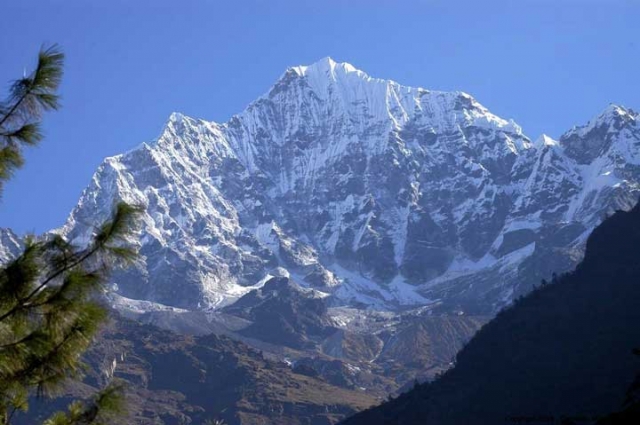Ganja La Chuli (5,844) also known as Naya Kanga Peak is a popular trekking peak of Nepal situated in Langtang region. Langtang is a popular destination for climbing snow peaks and spectacular panoramic views of mountains in Nepal and Tibet . The availability of several snow peaks scattered around in Langtang for acclimatization make this region an ideal destination for mountaineers. Many small peaks in this region which require no previous climbing experience are suitable for even trekkers to have little taste of what’s like climbing in Nepal .
Naya Kanga (5,844) is an attractive peak rising to the west of the Ganja La (5,122m) . Ascending to Ganja La or the summit of Naya Kanga offers the spectacular panoramic views of mountains in Nepal and Tibet including Langshisa Ri (6,370m), Pemthang Ri (6,836m), Shisapangma (8,046m), Langtang Lirung (7,425m), Pemthang Kapro Ri (6,830m) and Langtang II (6,571m). We follow the route of Langtang trek to Kyangjin (3,749m) for the ascent of Naya Kanga. To the north above Kangjin, there are several hills that provide both the magnificent views and the acclimatization. North – east of Kyangjin Ri (4,700m), there are two peaks; Yala Peak (5,500m) and Tsergo Peak (5,749m) that provide good climbing for acclimatization. The normal route for Naya Kanga peak climibng is North – East Face & North Ridge.
Day 01 – Arrive in TIA- Tribhuwan International Airport in Kathmandu 1350 m, meet our representative and be transferred to the Hotel.
Arrive in TIA- Tribhuwan International Airport in Kathmandu, meet our representative and be transferred to the Hotel. Be briefed about the trip of the coming days. Accommodation and dinner at the Hotel. Kathmandu altitude 1350 m.
Day 02 – Half day Sightseeing in Kathmandu valley’s important places.
Receiving permit for the climbing Ganjala Chuli (Naya kaga) situated at the height of 5844m. Half day sightseeing which includes important touristy spots like Pashupatinath; sacred Hindu shrine of all Hindu of the world and listed to the World heritage site. Similarly Boudha stupa and Kathmandu Durbar square.
Day 03 – Kathmandu to Syabrubeshi 1462 m
Kathmandu to Syabrubeshi 1462 m Get up early in the morning, check everything made ready to take with you to the trekking and climbing. Breakfast and lunch will be served in the local restaurant on the way. Tourist Bus service is not operated to the area we area heading forward. So compromise to travel with local bus with local people or rent a private vehicle. Arrive at Syabrubesi, the last destination of the day. Food and accommodation in Syabru at Hotel.
Day 04 – Shyabru besi to Lama Hotel 2600m
Shyabru besi to Lama Hotel 2600m though fourth day of the trip, it is our first trekking day. SO you must be quite excited to walk up to Lama Hotel situated at the height of 260m or so. Scrutinize the village, people, and natural phenomena and be freshet. Our guide will explain you all the necessity factor of trip while walking.
Day 05 – Lama Hotel to Langtang 3307m.
Lama Hotel to Langtang 3307m. Langtang is a beautiful village situated in the lap of langtang Himalayan ranges. Majority of the people are from Tamang tribe who are naturally very friendly, simple and helpful. Be friendly with them and pass smile to get smile. It is about 5-6 hours of walking day.
Day 06 – Lanhtang to Kyanjing Gompa 3049m
Lanhtang to Kyanjing Gompa is surrounded by Mt. Langtang Lirung (7245m) on the west, Yala peak on the north, Dorje Lakpa (6966m), Urkeinmang (6387m), Loenpo Gang (6979) and Kangchenpo on the northeast. There are small Buddhist monasteries and a cheese factory started in 1955 by the Swiss Association for Technical Assistance in Kyanjing Gompa.langtang to Kyanjing Gompa .It will be a long walking day to reach kyanjing Gompa.You will be there by the evening and be accommodated in one of the best available hotel/lodge at the area. Always feel free to ask anything you need with our guide and he will be ready and happy to serve you.
Day 07 – Rest day.
Rest day. We take rest today to acclimatize to go to the Ganjala Chuli Base Camp tomorrow. Explore around the area and take photos and enjoy the rest day.
Day 08 – Kyanjing Gompa to Naya Kanga Base camp 5000m
Kyanjing Gompa to Naya Kanga Base camp 5000m It will also be one of the long walking days to get Ganjala chuli Base camp. It will not be so difficult to trek up to there because of the previous days rest. We will be staying at the Base camp today.
Day 09 – Naya Kanga rest in Base camp 5410m
Naya Kanga rest in Base camp 5410m It is good to rest today again to be fit to climb up to high camp tomorrow. These days are difficult and technical days of our trip and it will be wisdom to follow the instruction of climbing guide carefully.
Day 10 – Naya Kangai Base camp to High camp. 5297m
Naya Kangai Base camp to High camp. 5297m It is a technical and difficult day but not that difficult. It can rather be said more adventurous and unforgettable day of the trip. It will be a kind of feeling of pride and something different done in the life. You happened to forget everything and you happened to feel you are one of the mountains yourself and you think you are talking and playing with these.
Day 11 – Attempt to summit 5846 m.
attempt to summit 5846 m. It is an extra day to attempt to summit the Naya Kanga Peak. This peak is the mixture of technical and easy climbing. We suggest you to be firmed nicely while climbing and suggest not making any rampant kind of handling.
Day 12 – Summit Naya Kanga and back to Base camp
Summit Naya Kanga and back to Base camp we did the great job of summiting Naya kanga peak situated at the height of 5,846m. We come back to the Base Camp. Over night at the Base camp again (BLD Plan).
Day 13 – Base camp – Kyanging Gompa – Langtang village
Base camp – Kyanging Gompa – Langtang village It will be possible to come back to the Langtang village today where we resided on the fifth day of our trip while going to the Naya Kanga trekking and climbing. Say hello again to the people you met before and tell them you have done a great job of being on the top of the peak. Make some fun and try to live in the same hotel you lived before. (BLD Plan)
Day 14 – Langtang Village to Lama Hotel
Langtang Village to Lama Hotel Scrutinize the village, people, and natural phenomena and be freshet. Our guide will explain you all the necessity factor of trip while walking.
Day 15 – Trek to Lama Hotel (2500meters) 5 hours.
Today, the first part of the trail crosses through Bhote Koshi and follows the Langtang Khola. This trail gradually climbs to Bamboo passing through the landslide area. Afterwards, your trek ascends gently to Rimche (2400meters) through Bamboo (1960meters) which lies at the bank of Langtang Khola. You can have lunch at this place if you like. Your trail is level to the Lama Hotel. En route you could see red pandas, monkeys and bears if you’re lucky. Overnight at guesthouse.
Day 16 – Shyabru village Dhunche 966 m.
Drive from Kathmandu to Syabru Besi which takes about nine hours by bus or Land cruiser depending on group size. You head north out of Kathmandu driving through scenic foothills and ridgeline vistas to Syabru Besi passing through Dhunche. While passing along the road at the bank of Trishuli river you catch a glimpse of Ganesh Himal, terraces and green hills. As you pass through Dhunche you feel as if you are heading towards deep land. At the same time, you notice that the road is still under construction. Sybru Bensi the cool town with the excellent view. Overnight at guesthouse.
Day 17 – Drive Dunche to Kathmandu
Drive Dunche to Kathmandu Arrive at Kathmandu have breakfast lunch on the way back to Kathmandu in local restaurant today again and transfer to the same hotel.
Day 18 -Leisure day in Kathmandu.
Extra day in Kathmandu for relaxing and some shopping , if you are interested in continuing onto Chitwan Jungle Safari, River Rafting Adventure, Kathmandu Shopping Tour or Scenic Everest Flight.
Day 19- Transfer for your final flight departure.
The trip ends, our Airport Representative will drop you to the Kathmandu International Airport for your flight departure from Nepal.
NOTE: The above information is a guide and standard template of what we provide. The trek can be customized at your request to accommodate your specific requirements.
NOTE: On adventure trips of this type, weather, local politics, transport or a multitude of other factors beyond our control can result in a change of itinerary. It is, however, very unlikely that the itinerary would be substantially altered; if alterations are necessary the leader will decide what is the best alternative, taking into consideration the best interests of the whole group. Where a change does occur, we do everything we can to minimize its effect, but we cannot be responsible for the results of changes or delays.
Q. How fit do I have to be and is trip for me?
A. Climbing Peak provides the most adventurous experience with spectacular scenery through remote glaciated valleys and passes. This trip requires you to have an above normal level of fitness which will assist with climbing Peak. Any person suffering from a pre-existing medical condition or diseases must seek medical advice before considering this trek. Whilst on the trek, it is common to experience some discomfort before being fully acclimatized.
To prepare for a strenuous trek you should begin training at least two to three months before your departure. As a guideline, an hour of aerobic exercise three to four times per week would be considered a minimum requirement. The best preparation is bushwalking involving relatively steep ascents and descents. If you can manage a couple of valley floor to ridgeline ascents per comfortable and able to enjoy the trek to the fullest. They are physically strong, sharp-witted and have an incredibly positive attitude towards a life that we would consider extremely tough. There is something about a trek in the Himalaya that draws you back time and time again. For keen walkers it is a paradise and even avowed non-walkers find that one foot just seems to follow the other, drawn by the appeal of what lies beyond.
Q. Will somebody come to pick me up at the Airport upon my arrival?
A. Yes, our Airport Representative will be there to greet you outside of Terminal Hall, he/she will be displaying an Kiwi Adventures Treks & Expedition sign with your name on it. Upon arrival, you will be transferred to your hotel.
Q. What sort of accommodation can I expect in Kathmandu and in trekking?
A. We use standard rooms from three/four star hotels in Kathmandu with breakfast included. Along the trekking routes teahouses/Lodges generally provide basic clean facilities with a mattress and a quilt or blanket. We can also offer you sleeping bags if needed (which need to return after the trip) but it is good idea to always have your own sleeping equipment. We usually provide single and double rooms as well as the occasional dormitory. The dining room is downstairs around a fire. All food will be cooked to order in the little kitchen. You should not enter the kitchen unless asked to do so.
Toilet Facilities – On trek, common toilet facilities are available at Tea Houses.
Q. What sort of food can I expect in trekking?
A. Most teahouses (lodges) cook a delicious range of mostly vegetarian fare. Pasta, tuna bakes, noodles, potatoes, eggs, dhal bhat, bread, soups, fresh vegetables (variety depends on the season) and even some desserts like apple pies, pancakes, and some interesting attempts at custard. You will find a lot of garlic on the menu because it assists with acclimatization – eat some every day. In many larger villages you may find some meat on the menu. You can always get hot chocolate, tea, and hot lemon drinks, as well as soft drinks, and treats like chocolate and crisps.
During the Camping, our export camping cook can prepare specially requested food if you advise. In any case, you will have similar fare to teahouses.
Each day dinner and breakfast are used to take in the same lodge you spend the night. Lunch will be taken on the way to destination.
Q. What sort of transportation you use?
A. Kiwi Adventures Treks & Expedition is all about providing you with local insights as well as adventure, with that in mind, where we think you will get more out of your holiday by using different means of transport that is what we do. Using a variety of private transport is an integral part of our Himalaya tours and enhances the experience!
We use private tourist vehicles for sightseeing, city tours and pickups. Depending on the group size we use cars, minibus, van, land cruiser. These small light vehicles are more manoeuvrable and flexible enabling us to take you through the Narrow roads of Nepal. All the vehicles are usually air-conditioned unless we are travelling in cooler areas.
Q. What is the best season for this trip?
A. The best time for this trip is October to November and March to May.
Q. What is the weather & temperature like in trekking?
A. Weather in the mountains is notoriously difficult to predict. At night it is generally cooler with the days being warmer, and in winter (January and February) it will be bit colder but the days can be quite beautiful and warm if the sun is out. There will be snow any time of year. It is also important to make sure that you can stay warm and dry in just about any conditions. Expect the unexpected! The temperature could be as high as 20 deg C to -15 deg C low.
Q. Can I charge my digital camera or other batteries on my trip?
A. These facilities will be available in most of the places in your hotel reception by paying some service charges. Remember to bring your adapters!
Q. Is there any communication while we are on trekking?
A. There are telephones in some villages along the trekking routes from which you can make international calls.
Q. Can I use credit cards in the places visit in trekking?
A. In most cities yes, to some extent, however once you leave those cities behind you will only need cash.
Q. How much additional money do I need per day?
A. In Kathmandu, you can allocate US$ 10 – 25 for a lunch / dinner. It’s all depends on your spending habits. US$10 to 20 US$ a day will be enough to buy bottles of water, chocolates and few drinks in trekking.
Q. Do I need to tip my guide and porters? How much would that be?
A. This is a difficult thing to judge. We have seen everything from 20USD to 1000 USD per person for guides and porters. Tipping is not required, but a small way to show your guides and local porters thanks for their help. The level of the tip should reflect the level of personal involvement with your guide.
Q. Is the water OK to drink? Do I need to bring purifying tablets/filter?
A. In most places bottled water is readily available. But it is important for you to drink normal water, so bring purifying tablets with you. During camping we provide boiled water to drink.
Q. Are the Kiwi Adventures Treks & Expedition staff insured?
A. Our company insures all our trekking staff, including guide, cook, Sherpa and porters.
Q. What essential documents do I need to bring with me on tour?
A. *Valid Passport – must be valid for up to 6 months after you return from your tour, keep a separate photocopy.
*Travel insurance, keep a separate photocopy
*Cash and Traveller’s Cheques, keep numbers and proof of purchase separate
*Flight tickets
*Emergency contact numbers for T/C’s, banks, insurance, family contacts.
Q. Can I add extra days to my trekking trip?
A. A trekking holiday should never be about making it to the final point quickly. Along your trek we can add days at your request with additional costs to cover guides, porters, accommodation and food.
Q. Do you use yaks/porters on the trek or do we carry all of our own gear?
A. Whilst on the trek, our porter will take care of your luggage. All you need to carry is your small day bag for your personal belongings like camera, water bottle, sun cream etc only.
Q. What opportunities will I have for shower along the trek?
A. In major places, we arrange guesthouse with hot shower. And in rest of the places, hotel water in bucket will be provided for shower; it would cost you extra about USD 5-8 per shower.
Cost Includes
• Airport / Hotel / Airport pick up & drop by private car / van / bus.
• Standard twin sharing accommodation in three/four star hotel in Kathmandu breakfast included (4 nights)
• Guided city tour in Kathmandu by private car / van / bus.
• All your standard Meals as per itinerary.
• Hot drinks during tented camping.
• Twin sharing tea Houses / Lodges, Guesthouses and Tented accommodation during the trek (7 night’s trekking guesthouse and 3 night’t tented camp).
• A government licensed English speaking Guide during the trek and climb.
• The required number of staff and Porters to carry your luggage during the trek.
• Food, accommodation, salary, insurance, equipment and medicine for all staff.
• Langtang Conservation Area Park permits.
• Ganja La Chuli/Naya Khang Permit fees.
• Garbage Deposit Fee.
• General Climbing equipments such as Rope, Ice Screw, Snow Bar etc.
• Surface transfer from and to Kathmandu.
• All our government taxes.
• Official expense.
Cost Excludes
• Lunch and dinner whilst in Kathmandu
• Your travel insurance (compulsory).
• International airfare and airport departure tax.
• Nepal entry visa, you can obtain easily upon your arrival at Tribhuwan International Airport in Kathmandu. (US$ 25 or equivalent foreign currency is required to obtain Tourist Visa with Multiple Entry for 15 days. Likewise, Tourist Visa with Multiple Entry for 30 days can be obtained by paying US $ 40 or equivalent foreign currency. Similarly, Tourist Visa with Multiple Entry for 100 days can be obtained by paying US $ 100. You will also require 2 passport size photos.)
• Alcoholic, hot and cold drinks, laundry.
• Personal trekking and Climbing Equipment.
• Tips for trekking staff (Tipping is expected).
• Sightseeing/Monument entrance fees.
• Any others expenses which are not mentioned on Price Includes section.







